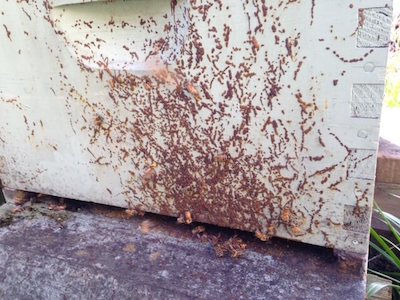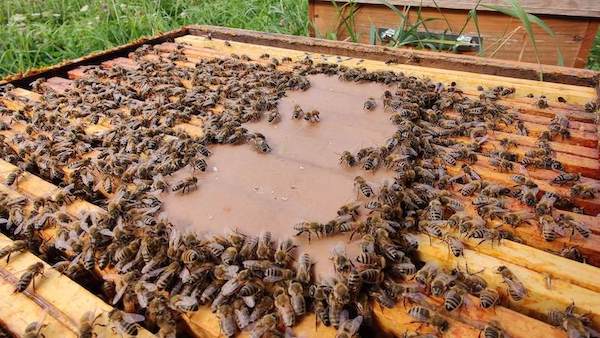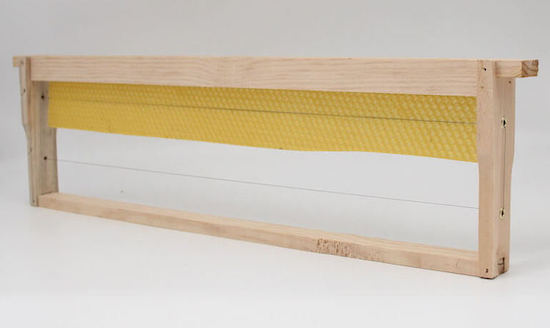 by Juan Molina
by Juan Molina Increasing daylight hours, occasional rain, daytime temperatures rising… each spring offers us a chance to work and derive the best from the hives. During winter many hives are left unopened for inspection.
The end of this dormant period marks a critical moment for the colony as it has been relying on its food reserves throughout the colder months. Likewise, any uncontrolled disease can result in non-viable colonies or even their collapse.
For a successful spring buildup, the focus should be on two fundamental aspects: health status and stimulation, along with other zootechnical management actions to facilitate the process. The beekeeper can plan their first inspections as soon as the weather permits. A sunny, windless day with temperature above 16ºC (61°F), around midday, would likely be ideal.
The initial inspections should be conducted as swiftly as possible to minimize disturbance and prevent cooling of the hive, while ensuring no critical information is overlooked. Preparing your material in advance is crucial; there is nothing more frustrating than arriving at a distant apiary only to find you can’t complete a task due to missing necessary tools or equipment. Always bring clean tools and clothing, and have feed ready for hives that may require it due to a higher population consuming their stores more quickly.
Start with a visual inspection of the entire apiary, examining the hive entrance and the ground immediately beneath for signs of abnormal activity. In cold and damp conditions, bee activity may not visible from the outside, as bees remain clustered together. In that case, gently lift the hive to gauge the weight of the food reserves, which provides an indication of their sufficiency.
On warmer days, a brief inspection can be undertaken to assess the colony’s vitality and check for the presence of eggs and young larvae. Evaluate the quantity and condition of the food reserves left months ago, ensuring that they are positioned close to the cluster. Bees venturing too far from honey risk cold paralysis due to a drop in body temperature. Also, if honey has been left instead of a patty, it should not be excessively hardened by the cold. Place such frames adjacent to the bees to keep their feeding source accessible, preventing starvation and cold-related deaths.
During your apiary inspection, if you encounter signs of mortality, bees displaying tremors, or notice blackish diarrhea spots, prioritize that hive for inspection last to prevent potential spread of issues.

When inspecting a hive, it’s crucial to evaluate the health of the colony by examining the brood chamber. Pay close attention to the quantity of larvae and the condition of capped cells. Look out for abnormalities such as sunken caps, blackish coloration, holes in the opercula, or any unusual odors. These signs could indicate health problems within the hive.
The brood pattern serves as a reliable indicator of colony health. A compact and uniform brood pattern is ideal, indicating healthy development. Conversely, a scattered brood pattern should raise concerns about the health of the brood and the colony overall.
Renewing wax is also vital for maintaining colony health, as old combs can accumulate organic debris that harbors infectious agents. Frames with blackish wax should be removed from the hive and sent for melting, sterilization, and lamination, eliminating potential sources of infection.
Understanding the specifics of your local climate and flowering schedules is crucial for effective beekeeping, especially in light of climate change impacts that may shorten the flowering season. Preparing well in advance is essential, with various actions aimed at boosting hive vigor before flowering begins.
Stimulus feeding is designed to increase breeding activity earlier than would occur naturally, aligning the hive’s peak population with the start of the flowering season. Given the lifecycle of a worker bee—from egg to forager—takes approximately six weeks, initiating egg-laying stimulation at least six weeks before flowering is vital to maximize honey production, reflecting the direct correlation between colony development and yield.
Stimulus feeds should mimic nectar flow with liquid consistency but provided in measured quantities to prevent storage in combs. Instead, offer small, frequent amounts to ensure complete consumption. Syrup ratios can vary from concentrated (2 parts sugar to 1 part water) to lighter (1 part sugar to 1 part water), incorporating fructose or glucose as desired. Start with ½ liter (about 16.9 ounces) of concentrated syrup per hive weekly, gradually increasing to more than 1 liter (about 33.8 ounces) of lighter syrup. For nucleus colonies, halve these quantities.
Protein is also essential for healthy brood development. Starting from the second or third week of stimulation, introduce a pollen substitute or protein supplement to meet these needs.
Be prepared for the possibility that flowering may fail or be delayed due to weather conditions, requiring hives to rely on supplemental feeding until natural nectar flows begin.

After assessing hive health, it becomes apparent that apiaries exhibit variability in response to feeding and environmental conditions. Achieving a degree of uniformity within the apiary simplifies management, as it allows the apiary to be treated as a cohesive unit. Conversely, significant disparities among colonies within the same location can prolong visits, with each hive requiring individual attention for food, wax renewal, super placement, queen renewal, etc.
Some beekeepers designate approximately 10% of their hives within each apiary as support hives. These hives are not primarily for honey production but serve to supply breeding stock or replace lost queens. Alternatively, other beekeepers treat all hives uniformly and opt to enhance colony strength by transferring frames with brood from more vigorous hives to those that are healthy yet slightly lagging. It is crucial that both the donor and recipient hives are healthy to ensure the success of such interventions.
Hives with significantly lower populations can benefit from being combined into a single, more robust colony. To facilitate this merger and prevent aggression, it’s effective to blend the colonies’ odors by sprinkling powdered sugar or misting them with honey water. This strategy prioritizes the maintenance of viable hives over preserving multiple weaker ones on the verge of collapse. Non-viable hives not only consume valuable time and resources but also represent an unrecoverable investment.
Professional beekeepers recognize the value of young queens for their superior laying capacity, which results in more populous, hygienic, resilient against Nosema, and ultimately more productive colonies.
As the season progresses, with stimulus feeding and the onset of flowering, the colony should demonstrate clear growth, provided there are no diseases. This increase in brood necessitates vigilance for Varroa mites, which reproduce inside the brood cells. A sugar shake, alcohol wash or CO2 control revealing 2-3 mites per 100 bees indicates the need for preemptive action to prevent infestation.
However, spring, with its high brood activity, is not the ideal time for traditional acaricidal treatments, as these primarily target the phoretic (non-breeding) mites, constituting only about 20% of the mite population.
Integrated Pest Management (IPM) offers alternative strategies, particularly exploiting Varroa’s preference for drone brood. Beekeepers can encourage drone brood in three ways: using shallow frames that lead bees to construct drone comb beneath, inserting frames with commercially available large-cell wax sheets, or placing frames topped with a narrow wax strip, prompting bees to fill in with drone cells. After drone eggs are laid, these cells should be removed and destroyed within 28 days or as soon as they are capped, to prevent Varroa proliferation.

Spring is a crucial season for beekeepers, where strategic planning and proactive management pave the way for a successful honey harvest. Key practices such as requeening for vitality, managing Varroa mites with precision, and ensuring hive uniformity not only prepare colonies for immediate spring challenges but also lay the foundation for year-round productivity. Embracing these tasks with diligence ensures the health and vibrancy of hives, directly influencing the quality and quantity of honey produced.
About the Author
Juan Molina is a veterinarian from the Universidad de Córdoba with specialization in beekeeping from the Universidad Complutense. Deeply passionate about apiculture, he’s affiliated with the Asociación Malagueña de Apicultores and has authored two books on the subject. Juan’s roles have ranged from Quality Manager for honey to imparting courses for bee enthusiasts.
 by Juan Molina
by Juan Molina  by Antonio Pajuelo
by Antonio Pajuelo Join the Véto-pharma community and receive our quarterly newsletter as well as our occasional beekeeping news. You can unsubscribe at any time if our content does not suit you, and your data will never be transferred to a third party!
© 2019-2025, Véto-pharma. All rights reserved